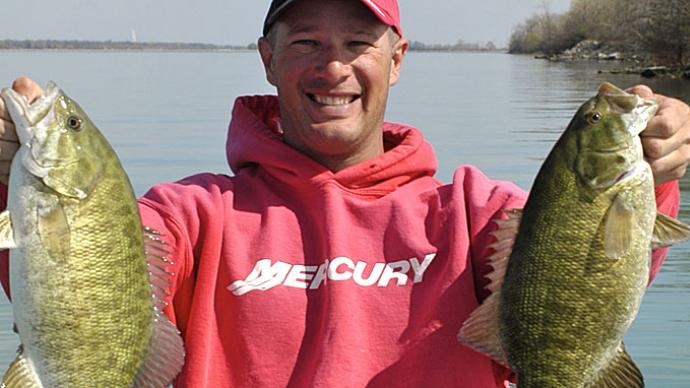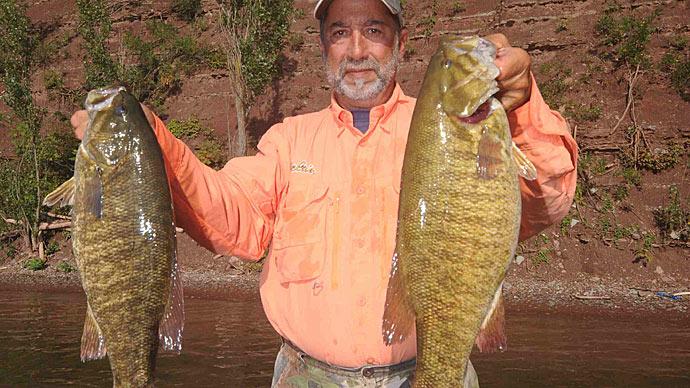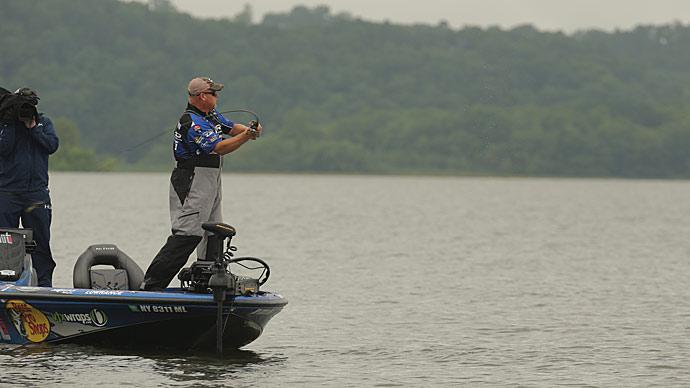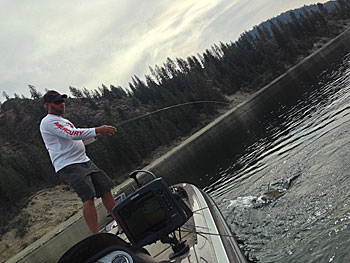
The best part of early fall, contrary to popular belief, is not football. There is no better time for anglers who are “in-the-know” to pursue smallmouth as they move from shallow to deep and their eventual wintering holes. Luke Clausen, 2006 FLW Tour and Bassmaster Classic Champion, Bassmaster Elite Pro Jonathon VanDam, and Canadian smallmouth ace Nick Cousvis share their wisdom on putting more fish in the boat.
Clausen lives in the state of Washington, where fall fishing starts early. “The beginning of September, you start getting those colder nights and shorter days which causes fish to change,” he said. “Many of those fish have been pretty stagnant in their patterns throughout the summer.”
Clausen concentrates on grass from Washington to Vermont and toward the northern lakes. He knows that perch will be in these grassy areas and the smallmouth feeding on them. He’ll look for shallow grass and especially cabbage weeds in deeper water if he can find them. He’s found that perch and baitfish congregate in the cabbage, especially in the Northwest, on the Great Lakes, and Lake Champlain and smallmouth will feed on that forage and suspend in the cabbage weeds as well.
If he can find any transition with rock mixed within the cabbage weeds, he’s confident he’ll be on quality smallmouth in short order. If the weeds grow within 4 feet of the surface, Clausen will throw a spinnerbait and grip his rod tightly as the action will be fast and furious.
Clausen knows that when the sun is out, the deeper fish will rise in the stalks of the cabbage and sun themselves. He will throw a ½- to ¾-ounce War Eagle spinnerbait in the spot remover pattern or one with a gold skirt and a bit of orange if there is no wind. “Those fish might be six to 10 feet down in the grass, and they can swim faster than we can reel,” he said.
He intends to create a reaction bite with his spinnerbait by smoking it over their heads while constantly twitching the rod tip. Clausen recommends using a 7-5 Megabass Orochi XX Extreme Mission Type F with 16-pound Gamma Edge Fluorocarbon line. He favors the rod because it is a rocket launcher, and the parabolic bend can tame even the most complex charging trophy smallmouth.
He’s not as big a fan as he once was of colored blades supposing perhaps smallmouth have seen too many of them over the years. He might combine a white and gold size 3 and 3.5 willow leaf blades or even a plain white tandem. You can bet with that blade configuration and a 7:1 rate of retrieve, he’s able to create the perfect illusion of a small school of bait zipping by.
Clausen also fishes topwater first thing in the morning or between 4 p.m. and 5 p.m. at the end of a regular tournament day. He will look to throw a Megabass Giant Dog X in GG Perch early in September.
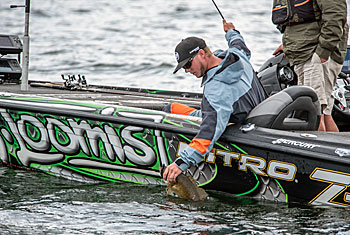
Jonathon VanDam, a life-long Michigan resident, knows how fantastic smallmouth fishing is during the fall. VanDam has fished for smallmouth on most northern lakes in Michigan, Lake Erie, Lake St. Claire, and Lake Huron.
“Usually, I’m looking for that mixture of rock and sand or gravel and boulders,” he said. “You must have sand holes and then rock mixed in where you have a defined edge. It might be spotty, a defined edge, but those fish are getting up there, and the baitfish are getting shallower and pushing up on those flats.” His problem with fishing the typical rock flats that most anglers gravitate toward is that they are big and expansive and little to differentiate where smallmouth could gang up.
There will be critical areas typically holding five to eight fish on the flats. Once he catches fish on a flat, he can look for similar features and duplicate the pattern. These areas are not known to contain giant schools of smallmouth, but an angler can still find success.
VanDam will probe the shallows from 55-65°F and usually use a three-pronged approach. A Strike King Red Eye Shad is the go-to bait if there is some breeze. VanDam prefers to throw the bait on a G-Loomis CBR 906 paired with a Metanium XG or Antares XG with 8:5:1 gearing with 12-pound Bass Pro Shops XPS fluorocarbon.
Much like Clausen, an erratic retrieve is best. Craw, perch, natural shad, and sexy shad patterns are all productive. He prefers to swap out his stock hooks for a set of Lazer Trokar #EWG trebles. Much like Clausen, he’ll work the bait erratically to elicit strikes. Should the wind calm down and the water slick over, he’s got a few options: the KVD Sexy Dawg walking bait or Strike King HC KVD Splash Popper.
Fished on a G-Loomis NRX 894C JWR and 12- to 14-pound XPS fluorocarbon, VanDam will rig a KVD Magic, blue glimmer, and ayu colored Caffeine Shad on a ¼-ounce ball head jig or a Strike King Squadron head.
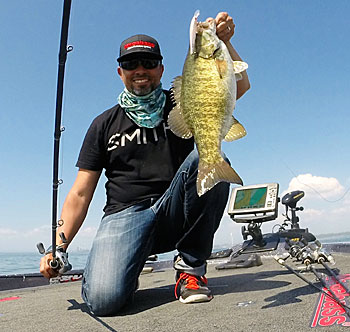
Nick Cousvis is a seasoned veteran on the Canadian tournament scene and recently won the CSFL 2015 Kawartha Cup on Rice Lake. Cousvis has been obsessed with jerkbaits since he converted many years ago from being a dyed-in-the-wool tube jig fisherman. Through years of experience, Cousvis has identified two main patterns for success when fishing Lake Ontario – proximity to deep water and perch.
He will seek out areas near wintering holes smallmouth use. “On Lake Ontario, I want to have depth, at least 50 feet nearby. I get my largest groups of fish in those areas. If it’s more than 500-600 feet away from that 50-foot range, I don’t bother,” Cousvis said.
While gobies and crayfish are the predominant forage during the summer on Lake Ontario, come fall, it’s all about the perch. “In the fall, when you get that east wind that blows warm water out of the shallows and that cool water that rolls in is an amazing pattern,” he said.
“Those smallmouths follow cold water in, they gorge on perch, and they’re gone. That jerkbait bite in shallow water on Lake Ontario in the fall is huge for me. They move in with big pods throughout the day, and another pod moves in again.” Once the water hits 55°F, they’re gone.
Cousvis finds confidence in a Megabass Vision 110, Megabass Vision 110+1, and the smaller of the three, the Megabass Trick Darter. While there is some validity to matching the hatch, Cousvis prefers to go against the grain. “I want my bait to stand out against what the fish are feeding on. I don’t want it to blend in. My confidence is to go as big as possible,” Cousvis said.
Once smallmouth move deeper than 5 feet, he’ll fish the Vision 110+1 exclusively. Unless they are following or snipping at the bait, he’ll opt for the smaller Trick Darter.
For anglers who have experienced the same non-committal behavior that smallmouth are notorious for, he suggests anglers consider the following. “Are you getting it deep enough? Are you using the right color? Are you using the right cadence?” Cousvis reasoned.
He’ll pay particular attention to what angle the smallmouth approached the jerkbait from. It uncorks a critical clue if a smallmouth approaches his jerkbait from beneath it. Those fish won’t come up that high in the water column, and if they do, they’ll see the boat and get spooked. If this is the case, Cousvis will work the bait deeper.
Cousvis prefers a 6' 9" Megabass Hyuga spinning rod pair with a 3000 series Stradic ci4+ or Shimano Sustain because these reels feature exceptional drag systems. A smooth drag is vital because you'll break the fish off if a big fish takes a run and the drag sticks.
Typically, he’ll throw 10lb Power Pro and a fluorocarbon leader, but if smallmouth are constantly hitting the boat, he’ll lengthen his leader up to 15- to 20- feet. “If they are coming up 20 feet away from the boat, I want all fluorocarbon, so they don’t straighten any hooks. When you set the hook close to the boat, many big fish go crazy, and because there is no stretch in the braided line, they’ll pull off, straighten hooks, or break hooks.”
He doesn't use fluorocarbon all the way through because on those long casts, during the first 20- to 30- feet of the retrieve, the bait is not doing what you want it to do. It is barely moving due to the stretch in the line.
“Once you get to the middle of your retrieve, it starts acting nicely. I want it to react the way it should 20-30 feet away from the boat because so many times, during the first two or three twitches, you get that big fish,” Cousvis said.
The Canadian angler connects to the bait with a size #1.5 egg-shaped Owner Hyper Snap or Decoy #2 egg snap. If the snap is too narrow, it kills the action a bit. He prefers the snap to avoid his not getting cut on the ridge of a split ring to facilitate a quicker change of colors. He even believes the sound of the split-ring and snap clanging together might trigger smallmouth to bite or attract the fish's attention.
When Cousvis sees fish coming up from behind the bait, he’ll shorten his twitches, keeping them tight to make his bait dart side to side but not go anywhere. I want to keep that bait in the strike zone as long as possible.
When Cousvis has followers in tow, he’ll kill the bait, and as a fish approaches near the bait, he’ll twitch the bait a couple of times, often resulting in the desired strike. He’ll be super stealthy by wearing subtle hues like white or gray not to spook any smallmouth as they are hypersensitive to all visitors not typical to their environment.
While part one of this article looked at the first period of fall, part two will look at how smallmouth begin their move toward winter haunts with a stop or two along the way.


